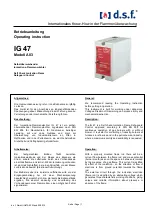
Version No. 1-1 - 09.11.2022
Doc. No. 99755520B001
5 / 27
4. Settings
Air - water heat exchangers are intended as complementary accessories to large industrial equipment which
include a motor-operated fan or blower together with a cooling heat exchanger. These may also include an
electric heater. The fan or blower is intended to recirculate air and allow heat exchange. The heat exchanger is
designed for chilled water or anti-freeze/corrosion inhibitor mixed water from a separate source.
The cooling function may be controlled by an on-board or remote controller or thermostat, a thermostatically
controlled valve or an electrically controlled valve. Heating function, when installed is provided by an electrical
heating element. The unit seals the cabinet which ensures that the clean air inside does not come into contact
with the ambient air which may well be dirty or polluted. The unit is fit for purpose within the rated/declared
ambient conditions (e.g. dusty and oily air or high air temperatures between 1°C and 72°C), also indicating the
rated allowable ingress and environment.
Water quality
To ensure the maximum lifetime of an air-water heat exchangers, it is important to supply cooling water in
conformity with the VGB Cooling Water Guidelines (VGB-R 455 P). The cooling water used must be soft enough
to avoid scale deposits, but should not be too soft as this would corrode the heat exchanger. Where the cooling
water is cooled for reuse, part of the water has to be changed with fresh water to prevent the concentration of
hardness and salt content which makes the water more corrosive.
The main impurities and possible methods of eliminating them are given in the table below:
Pollution of the water
Method of elimination
Mechanical impurities (dp > 2mm)
Filtration of the water
Excessive hardness
Softening of the water by ion
exchange
Moderate content of mechanical impurities
and hardness formers
Addition of dispersants or stabilisers
Moderate content of chemical impurities
Addition of passivators and inhibitors
Biological impurities (bacteria and algae)
Addition of biocides
When the water is re-cooled, it is recommended that the water condition is maintained as close as possible to
the following list of hydrological data:
Hydrological data
pH-values
7 - 8.5
Carbonate hardness
>3 <8
°dH
Free carbon dioxide
8 - 15
mg/dm³
Associated carbon dioxide
8 - 15
mg/dm³
Aggressive carbon dioxide
0
mg/dm³
Sulphides
free
mg/dm³
Oxygen
< 10
mg/dm³
Chloride ions
< 50
mg/dm³
Sulphate ions
< 250
mg/dm³
Nitrates and nitrites
< 10
mg/dm³
COB
< 7
mg/dm³
Ammonia
< 5
mg/dm³
Iron
< 0.2
mg/dm³
Manganese
< 0.2
mg/dm³
Conductivity
< 2200
µS/cm
Solid residue from evaporation
< 500
mg/dm³
Potassium manganate consumption < 25
mg/dm³
Suspended matter
< 3
mg/dm³
(part flow cleaning recommended) > 3 < 15 mg/dm³
(continuous cleaning)
> 15
mg/dm³






































